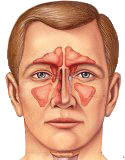Causes of EPISTAXIS
Epistaxis -
Nasal bleeding can be of two types depending upon the site of nasal bleed.Anterior bleeding mostly originates from the septum from its anteroinferior area called Little's area or Kisselbach's plexus.Posterior bleeding is from the so called artery of epistaxis i.e.sphenopalatine artery.
Causes -
1.Idiopathic - In most of the cases no cause can be identified.
2.Traumatic causes -
Nasal picking - It is the commonest cause of epistaxis in children.Nasal picking can cause injury to the Little's area causing bleeding from nose.
Nasal blows and road side traffic accidents causing facial injuries, nasal injuries and fractures cause nasal bleeding.
Iatrogenic causes like nasogastric and nasotracheal intubation.
Surgical causes like in septoplasty, submucus resection and endoscopic sinus surgery.
4.Inflammatory reaction (eg. acute respiratory tract infections, chronic sinusitis, allergic rhinitis and environmental irritants.
5.Chronic granulomatous diseases like tuberculosis,lupas vulgaris , syphilis, leprosy, rhynoscleroma etc
7.Intranasal tumors (Nasopharyngeal carcinoma in adult, and nasopharyngeal angiofibroma in adolescent males)
8.Midline granulomas - wegener's and stauwart's granuloma
9.Nasal sprays, particularly prolonged or improper use of nasal steroids
11.Barotrauma - Atmospheric changes such as sudden movement to high altitudes.
Systemic causes -
2.Hypertension - There is relationship between hypertension and epistaxis . In adults epistaxis is more common in hypertensive patients, and patients are more likely to be acutely hypertensive during an episode of epistaxis. Hypertension, however, is rarely a direct cause of epistaxis, and therapy should be focused on controlling hemorrhage before blood pressure reduction.
3.Vascular abnormalities - like sclerosed vessels, A-V malformations, hereditary haemorrhagic telengeactasia.
4.Bleeding tendencies - thrombocytopenia, liver disease, coagulopathies.
8.Systemic infections such as AIDS,typhoid, pneumonia, malaria, dengue fever, measles etc.
9.Pregnancy
10.Menstruation (vecarious menstruation)


0 Comments:
Post a Comment
Subscribe to Post Comments [Atom]
<< Home